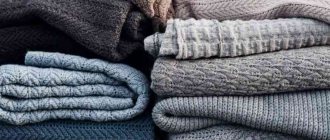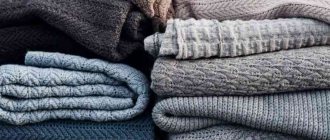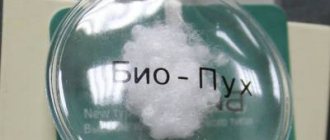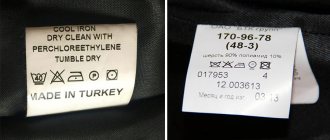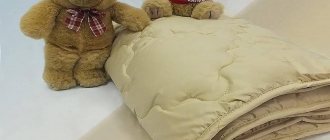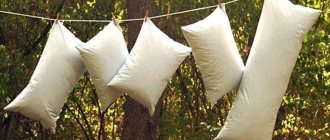Socks are an essential part of the wardrobe, without which no modern person can do. They are worn every day, so they are the ones that need washing more often than other things.
Few people realize, but it is the improper treatment of socks that leads to early wear, the appearance of difficult to remove stains and discoloration.
To make them last longer, you need to wash them correctly. For information on how to wash socks from dirt at home (in the washing machine and by hand), read the article.
Preparing dirty items for washing
Before you start washing, your socks need to be properly prepared. Basic recommendations:
Sort socks by color. White, black and colored items are washed separately.- Remove all visible dirt from socks. This could be threads, hair and other dirt.
- Turn the socks inside out. Sometimes it happens that small objects, pebbles and other debris get inside the product.
- Walk over the surface of the product with a machine to remove pellets.
If there are serious stains on the socks, they need to be soaked. If machine processing is intended, then you can select a special “wash with soak” program. To enhance the effect, a stain remover is added to the powder.
Soaking items during hand washing can be done using several methods:
- In a basin with the selected detergent.
- In polyethylene film. Socks are soaped and placed in a bag, leaving for 30-60 minutes.
When the preparatory activities are completed, you can begin washing the product.
Washing instructions
Knitted items need to be washed taking into account a number of factors. It is necessary to properly prepare them for the upcoming procedure, carefully squeeze the fabric from the water. Both hand and machine washing have their own nuances.
In the typewriter
A serious problem that all owners of knitted items face is pilling.
To prevent their formation, items should only be washed inside out. You can protect them from excess friction using a special washing mesh.
Procedure for machine washing knitted items:
- Clean the product from dust and other debris that may get caught in the hinges.
- Fasten buttons and zippers, check pockets.
- Turn the item inside out and place it in a laundry bag.
- Set the machine to “Wool” or “Delicate Wash” mode. If there is no such program, then the setting is carried out manually: water temperature - 30 degrees, spin speed no higher than 600 rpm. It is recommended to turn on the “extra rinse” function.
- Pour or pour the selected detergent into the washing machine compartment.
- Wait for the cycle to complete, take out the item, turn it right side out and leave to dry.
If synthetic fibers predominate in the fabric, then the water temperature can be increased to 40 degrees. To prevent the long neckline, cuffs or other delicate parts from stretching during the washing process, they are secured with thick thread. Remove it after the product has dried slightly.
How to do it manually?
Hand washing is considered a more gentle way to care for knitted items. A person has the opportunity to minimize the time they spend in water, as well as control the friction force at each stage.
Procedure:
- Fill the basin with water. Its temperature should not be higher than 30-40 degrees.
- Dissolve the detergent until a rich foam forms. For items made from natural wool, you can use hair shampoo.
- Turn the item inside out.
- Immerse the product in water. Soaking is necessary when there are difficult stains on the fabric.
- After half an hour, gently rub the item with your hands. Effort should be minimal. Only stains are treated in this way.
- Rinse the item thoroughly, changing the water several times.
- For the final rinse, you can add a little hair conditioner to the bowl.
After washing, the product is not wrung out or twisted. It is simply left in the bathroom until most of the water has drained. You can wrap it in a dry towel, it will absorb excess moisture.
When putting a knitted product away for storage after washing, it is not wrapped in plastic. Wool must breathe. She will lock herself in the bag and fall off.
How to wash in an automatic washing machine?
To prevent washing in a machine from negatively affecting the condition of your socks, you need to follow certain rules. They relate to selecting the optimal program, setting the temperature and choosing a detergent.
It is not necessary to wash each pair separately. For one-time loading, the following combinations are allowed: “white and light-colored items”, “black and dark blue socks”, “colored and plain dark ones”.
The general instructions are as follows:
- sort socks by color;
- clean them of debris and hair;
- turn the products inside out;
- load into the washing machine and wait until the cycle ends.
At what temperature?
The temperature you choose depends on the type of fabric the socks are made from. Most often there are no labels on them.
Manufacturers indicate washing recommendations on the label . Therefore, before throwing it away, you need to familiarize yourself with the care tips for specific products.
Cotton, synthetic and nylon socks are washed at a temperature no higher than 50-60 degrees. Products made from delicate fabrics, such as wool or silk, are processed in thirty-degree water.
In what mode (program)?
When choosing a washing program, you need to consider the type of fabric of your socks. If these are classic summer or terry products, then any mode will do. The main thing is that the temperature does not exceed 60 degrees.
Wool socks are washed using the “wool”, “delicate” or “gentle” wash program. It is recommended to turn off the spin or reduce the speed to 400.
Which detergent should you choose?
To wash socks in a machine, use regular laundry detergent.
If items made from delicate fabrics are to be processed, it is better to use a liquid detergent. It activates at low temperatures and rinses well.
It is important to consider the color of the fabric and the type of washing powder . Do not use products containing bleaches to process colored items. It is quite applicable to white socks.
When washing by hand, use laundry or any other soap. If you have stubborn stains, you can use folk remedies.
Rules for washing socks: modes and temperatures
How to wash correctly: in a machine or by hand? Here their quantity and material are taken into account. If only 3-4 pairs have accumulated, then there is no point in running the washing machine; it’s easier to wash it by hand. If the items are made of white fabric, then they should be washed immediately and not worn twice in a row.
Some people wonder: is it possible to wash socks along with panties and underwear? This is strictly prohibited. If you carry foot fungus, washing it together will transfer it from your socks to your underwear. The same goes for handkerchiefs and other clothing.
If you don’t know what you can combine socks with when washing, we will answer: it is better to wash them separately from all other things.
At what temperature should you wash? Preferably at least 80 degrees so that all bacteria and contaminants are removed.
How to do it manually?
Washing socks by hand is easy. There are 2 main methods:
- Using palm friction . Socks are put on your hands, moistened, soaped and rubbed against each other.
- In the basin . Detergent is diluted in it and the products are soaked. Difficult stains can be rubbed with your hands or a brush.
Sometimes they resort to unusual washing methods, for example, placing socks in plastic bottles with soapy water. Such containers are loaded into the trunk of a car and transported throughout the day. All that remains is to rinse the socks and hang them out to dry.
Read more about how to hand wash socks here.
Handwash
Many housewives believe that to achieve the desired effect it is better to wash things by hand. Besides, why turn on the washing machine because of 4 pairs of different colored socks? And if they require pre-soaking, then it’s easier to do everything manually.
Hand washing socks is a labor-intensive process, and if they are heavily soiled, it can also take a long time. Pre-soaking will make the job easier. Dirt will come out of the fabric faster.
It is extremely undesirable to intensively rub hosiery, especially synthetic ones! This leads to destruction of the fibers.
Detergents should be selected based on the material. Synthetics and cotton can be washed with regular powder or soap, wool - only with a special detergent. Use cool water to rinse. The procedure must be carried out several times.
Important! You can't twist your socks. To squeeze out the water, simply ball them up and press down.
It is recommended to dry things on a line or dryer, marking them in pairs or fastening them with a clothespin. Dark ones can be dried on a radiator.
Folk remedies for dirt and black soles
Sometimes classic cleaning products cannot cope with heavy stains. In this case, folk methods come to the rescue. They allow you to remove blackness from the sole, stubborn stains and stains.
Turpentine
Turpentine helps get rid of gray on white socks. Apply it as follows:
Dilute 3 tablespoons of turpentine in 10 liters of water.- Add 2 tbsp to the resulting composition. l. washing powder. Shake until completely dissolved.
- Soak socks overnight.
- Wash and rinse the item thoroughly.
Turpentine has a pungent odor, so you need to work with it carefully, protecting your respiratory system with a mask.
Bleaching
The most accessible means for whitening socks is bleach or bleach. With its help, you can get rid of difficult stains and whiten dirt that has gotten into your soles.
Mode of application:
- dissolve 2 tbsp in 2 liters of warm water. l. whiteness, add 100 g of washing powder and mix thoroughly;
- soak the socks in the resulting solution and leave for 1-2 hours;
- manually rub areas with stubborn stains;
- Rinse the product thoroughly.
Cotton and linen items can be soaked in bleach. Colored items and socks made from delicate fabrics will not tolerate such treatment.
Hydrogen peroxide and ammonia
A mixture of hydrogen peroxide and ammonia has a high cleaning ability. This composition allows you to quickly get rid of difficult stains.
Mode of application:
- For one part of ammonia take 2 parts of ammonia.
- The resulting composition is applied to contaminated areas and left for 15-30 minutes.
- Wash socks by hand, paying special attention to stains.
- Rinse the item thoroughly.
When working with ammonia solution and hydrogen peroxide, you need to wear gloves in a well-ventilated area.
How to remove stains and yellowness from socks
Successful stain removal depends on correctly identifying the substance that caused it:
- Blood – fresh blood is removed by washing in cool water (30 °C), and old stains are removed with products containing enzymes.
- Grass - treat with wine alcohol and wash.
- Coffee, cocoa - fresh stain - sprinkle with salt with added glycerin and wash.
A solution of soda and ammonia (4 tablespoons of ammonia and 10 tablespoons of soda per 10 liters of hot water), in which the socks should be soaked for several hours, will help get rid of yellowness on cotton socks. If this method does not work, things need to be boiled in a soda solution.
Aspirin is used to remove sweat stains, lipstick and whiten things. Crush 10 tablets, dilute in water and soak clothes, then rinse.
Dark stains from shoes will go away if the stockings are dipped in a solution of 1 tablespoon of turpentine and 2 tablespoons of any laundry detergent. Soak for 1 hour, squeeze out and wash with laundry soap.
Processing features depending on color: white, dark, colored
Dirt is more noticeable on white socks than on dark ones. Therefore, you have to wash them more often.
To remove blackness and prevent yellowing of the fabric, you can periodically use bleaching compounds. These can be chlorine-containing products, but you need to take into account that they lead to tissue damage.
The fibers lose strength and holes will appear on the product faster. Therefore, preference should be given to delicate bleaches containing enzymes and active oxygen.
Examples of such means are:
- Vanish Oxi Action Gold (the cost of 0.45 ml gel is about 145 rubles),
- Boss Maximum (for 0.45 powder you will have to pay about 50 rubles).
Colored socks are washed separately from other items, as they tend to fade and stain light-colored fabrics.
To care for them, stain removers that do not contain a bleaching component are used . The optimal washing temperature is 40 degrees.
Black socks are considered the easiest to care for. The stains on them are not so noticeable, so they are washed less often than white items.
However, they can only be processed with plain items . Even firmly dyed fabric causes white items to turn grey.
Read about the rules for washing white socks by hand here.
How to wash thermal socks
Proper washing will preserve heat-resistant properties. What conditions must be observed when washing thermal socks automatically and manually:
- temperature – 40 °C;
- product – detergent gel or soap;
- a large amount of water;
- no spin;
- drying at room temperature.
The fibers of thermal socks do not withstand mechanical cleaning, so you should not rub or twist the fabric. It is unacceptable to use brushes and abrasives. It is enough to hold the socks in soapy water, knead them with your hands and rinse several times.
Nuances for different materials
Depending on the material from which the socks are made, the features of caring for them will differ. The main recommendations are presented in the table.
| Woolen | Cotton, linen | Bamboo | Synthetics | |
| Washing temperature | 30 degrees | Up to 50-60 degrees | Up to 40 degrees | Up to 60 degrees |
| Washing mode | “wool”, “delicate”, “gentle” | “cotton - intensive wash”, “cotton - gentle wash” (the mode is selected depending on the degree of contamination) | “cotton – gentle wash”, “delicate” | “synthetics – gentle wash”, “synthetics – intensive wash” |
| Number of revolutions | Disabled, or no more than 400 | 600-800 | ||
| Detergent | Liquid detergent compositions | Powder, soap, gels | Liquid detergents | Powder, soap gel |
Socks made of delicate fabrics, such as wool, are recommended to be processed by hand.
Washing children's socks
A special feature of caring for children's things is the use of special products that do not cause irritation to sensitive children's skin. The washing process itself is no different from normal. Manual and automated processing can be used. The main aspects are keeping things soft and clean.
Socks are an important attribute for a person of any age and status. By following our simple instructions, you can easily keep your linen fresh, please your loved ones and gain confidence in the impeccability of your appearance.
For nail fungus
Nail fungus is a contagious disease . Microscopic particles of mycelium settle on all surfaces, including items of clothing.
To prevent the infection from spreading and leading to repeated self-infection, you need to wash your socks correctly.
Basic moments:
- When washing by hand, you need to use gloves;
- Items should be machine washed at maximum temperatures;
- It is recommended to boil socks every 3-4 washes;
- You can only load things into the washing machine that belong to a sick person.
To destroy fungal spores after washing, it is recommended to iron socks.
Read more about washing socks if you have fungus here.
How often should you wash your socks?
The usual procedure for changing socks boils down to the following rule: change daily, wash as accumulated or necessary.
It is not at all necessary to start the washing machine because of one pair. Also, you should not wash your socks separately from other clothes. The main thing is to sort by color and type of fabric.
In case of emergency, you can quickly wash your socks by hand.
The rule changes if you put a stain on the knitwear. In this case, there is no need to put off washing for a long time. Remember: the fresher the stain, the easier it is to remove.
To save time and choose the right solution, we offer a small checklist:
- You need to change your socks daily. A light degree of contamination will avoid rough washing, which leads to deformation of the knitwear and the formation of pills.
- You should wash as needed or when you have accumulated enough socks that you feel comfortable turning on the washing machine.
- When storing in a laundry basket, it is advisable to put one sock inside the other. In this case, you will save yourself the trouble of searching for a match. If possible, collect dirty socks in a separate container.
- We recommend that heavy dirt and stains be washed immediately. Old dirt penetrates deeply into the fibers and is much more difficult to wash off. There is a need to use stain removers and bleaches.
What is possible and what is not?
To save time and washing powder, people often throw not only socks, but also other things into the washing machine drum. However, the joint processing of some wardrobe elements is unacceptable . First of all, this applies to underwear.
With T-shirts
You can wash socks with T-shirts. However, you need to take into account the manufacturer's recommendations that are indicated on them. It is important that the products are the same color and from similar fabrics.
White T-shirts and black socks should not be loaded into the drum. Woolen and silk items are washed separately, as they require delicate treatment.
With panties
It is not recommended to wash socks with underwear . There is only one reason - hygiene standards. Socks come into contact not only with a person’s foot, but also with the floor covering and the inside of the shoe.
Therefore, not only dirt can settle on them, but also various bacteria, which, during washing at low temperatures, can move to the laundry and then to the intimate area.
If lace underwear is washed in a machine, then choose the delicate cycle. It won't fit most socks. They require more intensive processing. Under no circumstances should children's underpants and socks be washed at the same time.
Is it possible and how to properly wash socks and panties together in a washing machine? Read here.
With shirts
Shirts are washed either by hand or on a delicate cycle. Other programs may cause damage to the product.
If there are socks in the laundry basket that are the same color as the shirts and also require careful handling, then washing them together is acceptable.
With towels
Many housewives wash socks with kitchen towels. The main thing is that the products do not stain each other . As for personal towels, it is not recommended to load them into the drum together with socks for hygienic reasons.
Socks are worn on your feet, so a wide variety of germs can settle on them. A towel is a personal hygiene item that is used for the face, body, and intimate area.
These two things should not be combined. As an exception, such washing is possible, but at maximum temperatures.
Know the intricacies of washing
If you follow the rules of care, your socks will remain unchanged for a long time and will last longer. Washing is carried out in two ways: by hand and by machine. Both options have their own nuances.
In the washing machine
When machine washing, it is important to consider the quality of the products. For example, wool socks are considered delicate items - they react to temperature and spin speed.
Machine washing is completely contraindicated for pure wool socks. They decrease in size, fibers fall off, colored threads fade
Tip 1. Sorting.
Items with fragile colors fade during washing and spoil light-colored clothes. Sorting will help prevent this. Before putting it into the machine, sort by fiber/yarn quality and tone:
- white + light;
- colored + dark;
- black + dark blue things.
To prevent things from fading, sort your socks before washing: colored ones with colored ones, white ones with white ones, black ones with dark ones.
Photo: stozabot.com For hygienic reasons, many doubt whether socks and panties can be washed together. If things are sorted by color and quality of material, then you can.
Tip 2. Soaking.
Light and white things cause more problems. In the quick wash mode, heavy soiling cannot be removed. Soaking gives 100% cleanliness and improves the quality of washing. To do this, use store-bought liquid and powder products (Antipyatin, Vanish, etc.) or use grandma’s methods.
I suggest you get acquainted with effective folk methods for soaking. They cost a penny, but they remove any stains and, if desired, whiten them:
| Method 1. Boric acid or hydrogen peroxide White socks get dirty quickly, leaving stains that are difficult to remove. Boric acid or hydrogen peroxide is an indispensable remedy for them. Before washing, you need to make a solution and soak things. All impurities will disappear.
Soaking lasts 20–30 minutes, with occasional stirring. Old stains are moistened with undiluted acid and rinsed after 3–5 minutes. Boric acid can be replaced with lemon juice. Boric acid has bactericidal properties; with its help, deep disinfection of fabric fibers occurs. Be sure to use for skin problems, including fungal and purulent diseases. | |
| Method 2: Baking soda + dish soap Removes grease stains and dirt. Soaking solution concentration: 2 liters of water + 1 tbsp. l. soda + 0.5–2 tsp. detergent. Soaking duration is 1–3 hours. As a result, colored and light-colored socks will become almost clean | |
| Method 3. Potassium permanganate + washing powder The action of the manganese mixture whitens and cleanses. The soap mixture is made from a pale pink solution. For 5 liters of water add 1-2 tbsp. l. powder and half a glass of diluted manganese. You need to soak for 1 hour, you can leave it for a longer time (overnight). Rinse before washing | |
| Method 4. Aspirin Acetylsalicylic acid tablets will help remove dark spots and yellowish traces of sweat. Soaking or rather wetting problem areas is done for 1–2 hours. Recipe for preparing the solution: crush two tablets and dissolve in 100 ml of warm water. Saturate the stained areas and leave to act. Rinse before normal washing | |
| Method 5. Laundry soap An old, reliable way to remove any stains on colored and dark laundry is laundry soap. The alkaline base does an excellent job of removing any type of dirt, including grease and blood. For soaking, chips are used (the chips are crushed on a grater). It is enough to put 1-2 handfuls on a five-liter basin. This solution can be washed without soaking. Just soap the sock and leave it damp (put it in plastic) for half an hour |
Tip 3. Follow the rules.
1. Do not wash in hot water . Hot water is unacceptable for washing and soaking natural fabrics. The peculiarity of such fibers is to absorb and fix organic contaminants at high degrees (above +40 °C). The effect of hot water is the opposite: dirt eats into it and cannot be removed later.
2. Do not dry on the radiator . White clothes turn yellow when dried on a radiator.
3. Set to delicate mode. Wool socks need a gentle cycle: “hand wash without spinning”.
4. Turn inside out . Before putting them in the drum, turn your socks/knee socks inside out to keep their new look longer.
5. Wash by hand. To prevent the formation of pilling on wool and softly twisted knitwear, wash by hand, do not use excessive friction, strong spin, use conditioner-rinse aid.
+40…+60 °С
optimal temperature for washing socks
6. Maintain water temperature within +40…+60 °C. Light and white socks made of elastic, cotton, knitwear, and synthetics will not fade; you can choose any temperature within these limits.
Tip 4. Don't lose a couple.
When loading a machine drum with numerous socks, confusion occurs in the pairs. As a result, I then spend time sorting. To prevent your sock from getting lost in the washing machine, follow these rules.
The table shows the most convenient ways to look for where socks disappear from the washing machine:
| Method 1. Washing bag Place small items in a small mesh bag before placing in the drum. Any one will do: with a zipper, with a lace, with buttons. Things will not get lost in the net, and there will be no need to check the drum in search of a missing pair. You just take out the bag and hang things out to dry. | |
| Method 2. Sock elastic To avoid having to separate your washed socks into pairs, combine them using a sock elastic. Place one sock over another and pull the elastic of one over the other. In this form, everything stretches out well and is wrung out. To dry, the pairs are separated and hung side by side. | |
| Method 3. Clips There are special devices for connecting pairs on sale. The clips are made of soft plastic, do not stain fabric, do not break, and are easy to use. Clothes pegs for washing socks are also sold. Their design is a little more complex and they are prone to breakage. Both models are simple and easy to use - suitable for line drying - have hooks |
Manually
I wash my socks daily and hardly ever use the machine. There is a plus to this:
- does not accumulate a lot of socks;
- no sorting required;
- pairs will not get confused;
- no need to think about which mode to turn on the washing machine.
You need to wash socks made of wool, with the addition of mohair and that shed heavily by hand. The process involves lathering/soaking, rubbing and rinsing. I’ll tell you how to wash socks by hand in two interesting ways:
- The "mitten" method. Dry socks are put on like mittens and moistened. Lather with a bar of soap, as when washing your hands. Rub the area of your feet, heels, rinse under running water or rinse in a basin.
- Driver's method. 1 or several pairs of socks are loaded into a 5-liter plastic bottle and filled with water and detergent. A tightly closed bottle is placed in the trunk of the car. After several hours of driving, all that remains is to remove, rinse, wring out and hang to dry.
How to wash waterproof socks - care information in the table
Laundry bag
A bag for washing socks is a mesh product that is secured with laces or a zipper.
Its use allows you to solve several problems at once:
- Avoid socks getting tangled if they are loaded in large quantities at once or with other underwear.
- Extend the service life of the product. The mesh will be subject to friction against the drum of the washing machine, not the socks themselves.
- Do not harm the quality of the socks during spinning.
There are several types of bags. Small cases hold up to 2 pairs of socks. The cost of such a bag is 270 rubles.
You can also find large nets on sale, divided into 3 sections by partitions . For example, a product from Artmoon (250 rubles per piece). You can purchase mesh in hardware stores and online markets.
How to avoid losing socks in the wash
The disappearance of one sock from a pair during washing is a great mystery of humanity, the answer to which has not yet been found. Socks often disappear, getting stuck in the gap between the drum and the inner walls of the machine. You can solve this problem using several simple methods:
- To prevent one pair of socks from getting lost in the wash, you should put them in a mesh bag. You can sew it yourself, buy it ready-made in a store, or use a bag from a shoe package. Such a bag can be washed along with the rest of your clothes without fear of losing pairs.
- Connect identical socks with special plastic clothespins.
How to dry quickly at home?
You need to dry your socks naturally. If washing was carried out with a spin cycle, the products will dry completely in 3-4 hours. You can speed up this process by using an iron by ironing the pair from the wrong side several times. The steam function must be turned off.
Do not place socks on the radiator. This can lead to unsightly streaks and stains.
Special drying conditions are required only for woolen products. They are washed without spinning, after which they are laid out on a wire rack in a horizontal position. If you hang them, they may lose their shape.
Hand wash: 2 ways
How to wash socks by hand? I know two correct ways, which I present to you in the table:
| Illustration | Instructions |
| Method 1. With laundry soap The simplest method:
| |
| Method 2. With a bottle Car owners may like this option:
|
I would also like to mention washing wool socks . They can only be processed by hand, as the material is quite capricious and easily deformed. In this case, use special products for wool, and do not forget about the rinse aid.
It is better to wash woolen items by hand so as not to spoil the material
Not sure how to wash waterproof socks? Also - in warm water with a special solution. Dry them first inside out, then right side out.
Important Tips
To wash your socks and not render them unusable, you must follow the following recommendations:
- Socks are turned inside out before washing. This will allow you to maintain their attractive appearance for a long time.
- When washing socks with other items at the same time, you need to take into account the recommendations that apply to all products.
- When loading a large number of pairs, you need to use a special mesh.
White socks should be washed after each wear. This will prevent dirt from penetrating deep into the fabric. Bleach can be used periodically.
You will find maximum useful information about washing clothes and various fabric products here.
Woolen
Socks made of wool or angora are especially capricious when washing - they should be carefully washed by hand (or on a delicate cycle) using gels and special “Vorsinka” powder. An inexpensive shampoo will also work.
Socks made from terry or different types of wool are recommended to be washed on both sides in warm water and rinsed with conditioner. If your wool socks are shedding, you might want to add a little vinegar to the water.
Advice! To ensure that wool socks retain their bright color, you should soak them in cool, salted water for one to two hours before washing.
The water temperature during the main wash and rinse must be the same, otherwise wool socks may shrink.
Washing rules for socks
Before you start washing your socks, remember a few simple rules that will make your life easier and prevent you from making unpleasant mistakes. This information is not new to anyone, but these rules are not followed by everyone.
- Wash your socks every day. Reused socks under any conditions emit an unpleasant odor. Even if you don’t suffer from sweaty feet and it seems to you that your socks are still clean, change them, so they will last longer and will be easier to wash.
- Before washing, inspect your socks for tears; perhaps there is no point in washing them and they are just asking to be thrown in the trash.
- Before washing, separate white socks from black clothes. Even one black sock stuck among white clothes can leave dark stains that are difficult to remove.
- If your white socks have stubborn stains, do not wash them normally. Washing such items requires a special approach.
Wash dirt off socks by hand
Many people hate hand washing, although there is nothing supernatural about it. This simple procedure is familiar to everyone. The easiest way to wash dark socks is to just turn them inside out, wet them under running warm water, soap them with soap, rub them a little, rinse, wring out and dry. There may be some difficulties with white socks, we will talk about them a little later.
But if you tend to accumulate dirty laundry and then wash everything at once, then it is certainly wiser to use a washing machine. How to properly wash socks by hand. There are some tips from experienced housewives on this matter, let's look at them.
Mostly dirt of organic origin, mainly sweat, settles on socks, so it is better to wash them at a temperature of no more than 40 C, so that the dirt does not completely eat into the fabric. Moisten heavily soiled socks with water and rub thoroughly with soap. If the nature of the contamination requires the use of citric acid, hydrogen peroxide or salt, use these substances
Let the socks sit in contact with the chemicals for a while and then wash them. Pay special attention to the soles. Give them a good shuffle, as that's where the most stubborn dirt is found. Wear rubber gloves when washing, especially if you have cuts or abrasions on your hands.
Additional recommendations
Washing socks should not be taken lightly. This part of the wardrobe carries a large number of bacteria, and in addition, wears out quickly
To avoid spreading germs to other clothes and to extend their lifespan, it is important to mix and dry socks correctly
What you can wash with and what you can’t wash with
For hygiene reasons, it is not recommended to combine socks with underwear. You should also wash separately from clothes with Velcro or hooks, which may leave snags or tear the material. The couples will be accompanied by jeans, stockings, and tights.
If you have nail fungus, wash your socks by hand separately from other clothes. It is recommended to soak your socks every evening before the main wash in water with vinegar, hydrogen peroxide or chlorhexidine.
Drying rules
After washing, the socks should be hung on the dryer and left to dry at room temperature. It is convenient to use a hanging dryer with clothespins. It saves space and dries vapors without kinks.
Drying on a radiator or heated towel rail is not recommended, especially if the socks are made of synthetics. This will lead to shrinkage of the products. Woolen pairs are dried only in a horizontal position away from heating appliances.
To wash socks, you need to follow simple rules: turn them inside out, put them in an automatic washing bag, and use liquid detergents. Dirt will be washed off easier if you pre-soak the items in cool water.
